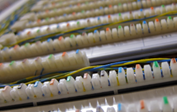Remembering Those Color Codes

[January 2025] Sometimes it is easy to remember the colors of wire used for connections, especially if there are only a few – black and red, for example. But if you have to remember a bunch of wires, it gets more complicated. Rolf has a mnemonic for you.
The color codes evolved with the evolution of telephone cable insulation.
With the introduction of Plastic Insulated Cable (PIC) the polyethylene or polypropylene insulation could be readily produced in colors. Initially two colors on one wire were not practical. Therefore, the tip conductors had one series of colors whereas the ring conductors had a separate sequence. This had the disadvantage of that ring colors were the same for each group of 5 tip conductors per 25 pair bundle.
Later, when PVC cable was introduced, this was solved by two-colored wires with most of a wire being a “background” color with a smaller amount of the “foreground” color being used with the appropriate color. Therefore, the two conductors of a pair could always be identified even if they became untwisted. However, the basic PIC color concept remains.
MODERN CODES BASED ON 25
Thus, the most common telephone/datacom color coding for copper cables used today is as follows for 25 pairs total.
For greater than 25 pairs there are typically binder groups of 25 pairs each. The tip conductor is mostly the Group color with a stripe of the Basic color, whereas the ring conductor is the opposite.
BASIC COLORS (originally Tip colors)
- Blue, Orange, Green, Brown, Slate
- A mnemonic: Bell Operators Give Better Service.
(Note- Slate is used instead of gray, so there is no confusion with green.)
GROUP/BACKGROUND COLORS (originally Ring colors)
- White, Red, Black, Yellow, Violet
- The mnemonic – Why Run Backwards, You’ll Vomit?
TERMINAL BLOCKS
When terminated on a terminal block, lines are terminated (top down on a 66 block or left to right on a 110 block) in Tip/Ring, Tip/Ring order.
For each background color there would be 5 pairs, each with one of the foreground colors (and its mating reverse-marked conductor). This gets repeated for each background color, for a total of 25 unique pairs. In some cases (such as category 5 and greater cable) within a binder group there are sub binder groups. In this case typically only the blue, orange, green, brown, and slate are used, with the same colors repeating in each sub group. The foreground colors match the tab colors on the most commonly used 110 punch blocks.
That means the pairs in a single binder 25-pair cable terminated on a 66 punch block would be as follows (main color/stripe):
White/Blue
Blue/White
White/Orange
Orange/White
White/Green
Green/white
White/Brown
Brown/White
White Slate
Red/Blue
Blue/Red
Red/Orange
Orange Red
.etc
.
Violet/Slate
Slate/Violet
Most modern (Cat. 5 or greater) backbone 25-pair cables have 5 sub-binder groups, with each binder bundle having 5 pairs. The color coding within each bundle would be the same, using Blue, Orange, Green, Brown and Slate and the background color (white usually) repeated for each group. For typical data applications that require 4 pairs per connector, the slate pair is used as a spare.
These colors directly correspond to the colors on the divider tabs on a 110-type punch block. (see picture)

The photo shows two types of 110 style punch blocks. The foreground block is intended to terminate 5 pairs in a group, having black tabs for the slate pair. The background blocks are intended to terminate 4 pairs. The slate pair, if present, would be left unterminated unless needed as a spare for a damaged pair of another color.
However, you will also run across a single group of 25 pairs coded as discussed above (usually for Cat 3 cable).
NEED MORE FIBER?
The author has noted that these same PIC colors are used on fiber cables, with the addition of pink (rose) and aqua.
Of course, fiber is not paired, but it does behoove one to uniformly install the colors in a mounting frame. The author terminates in the following order:
- Blue, Orange, Green, Brown, Slate, White, Red, Black, Yellow, Violet, Pink, Aqua
- And another mnemonic – Bell Operators Give Better Service. Why Run Backwards, You’ll Vomit Pink Again.
– – –
Rolf Taylor has over 30 years experience in dealing with operation and support issues. He currently is at Rocket Engineering and Consulting in Springfield, VA. You can connect with Rolf at rolf.taylor@yahoo.com
– – –
Would you like to know when more articles like this are published? It will take only 30 seconds to
click here and add your name to our secure one-time-a-week Newsletter list.
Your address is never given out to anyone.
– – –
